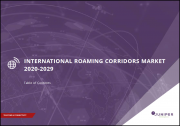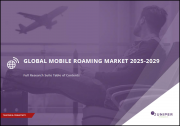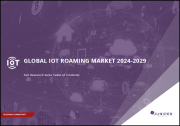
|
시장보고서
상품코드
1621280
로밍 요금 시장 : 서비스별, 로밍 유형별, 유통 채널별 - 세계 예측(2025-2030년)Roaming Tariff Market by Service (Data, SMS, Voice), Roaming Type (International, National), Distribution Channel - Global Forecast 2025-2030 |
||||||
로밍 요금 시장의 2023년 시장 규모는 769억 7,000만 달러로 평가되었습니다. 2024년에는 815억 8,000만 달러에 달할 것으로 예측되며, CAGR 6.16%로 성장하여 2030년에는 1,169억 9,000만 달러에 달할 전망입니다.
로밍 요금 시장에는 이동통신 사업자가 사용자가 홈 네트워크 밖에서 휴대전화를 사용하여 통화, 메시지 전송, 데이터 통신을 할 때 부과하는 요금이 포함됩니다. 시장의 정의에는 이러한 요금 체계가 다른 지역에서 어떻게 시행되는지를 형성하는 규제와 정책이 포함됩니다. 로밍 요금은 출장자, 여행자, 국경을 넘나드는 근로자의 통신 연결을 보장하고 중단을 최소화하여 원활한 통신 및 데이터 전송을 촉진하는 데 필수적입니다. 해외여행 증가, 세계화, 통신 기술의 발전이 이 시장을 주도하고 있습니다. 그러나 변화하는 정부 규제, 사업자 간 로밍 계약 관리의 복잡성, 비용 투명성에 대한 소비자의 요구는 큰 도전이 되고 있습니다. 또한, 많은 통신사들이 고객 확보 및 유지를 위해 로밍 요금 인하 및 무료화를 요구하고 있어 경쟁은 더욱 치열해지고 있습니다.
| 주요 시장 통계 | |
|---|---|
| 기준년(2023) | 769억 7,000만 달러 |
| 추정년(2024) | 815억 8,000만 달러 |
| 예측년(2030) | 1,169억 9,000만 달러 |
| CAGR(%) | 6.16% |
시장 성장에 영향을 미치는 주요 요인으로는 OTT 서비스에 대한 수요 증가, 출장자 증가, 이동 중 데이터 연결에 대한 수요 증가, eSIM 기술을 활용한 보다 유연한 사용자 계약, 실시간 로밍 사용량 및 비용 추적, 맞춤형 지역 로밍 요금제 개발 및 맞춤형 지역 로밍 요금제 개발, 통합 디지털 서비스를 통한 고객 경험 혁신 기회 통합 디지털 서비스를 통해 고객 경험을 개선함으로써 맞춤형 지역 로밍 요금제를 개발하고 시장을 혁신할 수 있는 잠재적 기회가 있습니다. 그러나 이 시장은 신흥 시장 간 인프라 격차, 정치적, 경제적 배경이 다른 지역 간 요금 조정을 위한 복잡한 규제 등의 한계에 직면해 있습니다.
잠재력을 가진 개발 및 연구 분야로는 로밍 결제 프로세스를 원활하게 하기 위한 블록체인 기술 애플리케이션 개발, 로밍 중 데이터 보호를 위한 사이버 보안 강화, 피크 시간대 네트워크 용량 예측 및 최적화를 위한 AI 활용 등을 들 수 있습니다. 등이 있습니다. 전반적으로 로밍 요금 시장은 비용 효율적인 연결을 원하는 소비자 수요와 부가가치 서비스를 제공하는 사업자의 전략에 힘입어 역동적인 특성을 가지고 있습니다. 기업들은 새로운 성장의 길을 개척하고 경쟁력을 유지하기 위해 데이터 분석을 통해 소비자 패턴을 이해하고, 기술 기업 및 지역 통신 사업자와의 전략적 파트너십에 초점을 맞추어야 합니다.
시장 역학: 빠르게 진화하는 로밍 요금 시장의 주요 시장 인사이트 파악
로밍 요금 시장은 수요 및 공급의 역동적인 상호작용을 통해 변화하고 있습니다. 이러한 시장 역학의 진화를 이해함으로써 기업은 정보에 입각한 투자 결정, 전략적 의사결정, 새로운 비즈니스 기회를 포착할 수 있습니다. 이러한 트렌드를 종합적으로 파악함으로써 기업은 정치적, 지리적, 기술적, 사회적, 경제적 영역 전반에 걸친 다양한 리스크를 줄일 수 있으며, 소비자 행동과 그것이 제조 비용 및 구매 동향에 미치는 영향을 보다 명확하게 이해할 수 있습니다.
- 시장 성장 촉진요인
- 스마트폰 및 기타 IoT 기반 용도의 사용 증가
- 여가 및 업무 목적의 해외여행객 세계 증가
- 국경을 초월한 원활한 연결에 대한 소비자 지출 증가
- 시장 성장 억제요인
- 국제 로밍에 따른 높은 인프라 비용
- 시장 기회
- 사용자의 소비 패턴과 위치에 기반한 동적 가격 책정 모델 등장
- 로밍 요금제에 부가 가치 서비스 통합
- 시장 과제
- 세계의 대체 통신 서비스 이용 가능성
Porter's Five Forces: 로밍 요금 시장 탐색을 위한 전략 도구
Porter's Five Forces 프레임워크는 로밍 요금 시장 경쟁 구도를 이해하는 데 중요한 도구입니다. Porter의 Five Forces 프레임워크는 기업의 경쟁력을 평가하고 전략적 기회를 모색할 수 있는 명확한 방법을 제공합니다. 이 프레임워크는 기업이 시장 내 세력도를 평가하고 신규 사업의 수익성을 판단하는 데 도움이 됩니다. 이러한 통찰력을 통해 기업은 강점을 활용하고, 약점을 해결하고, 잠재적인 도전을 피하고, 보다 강력한 시장 포지셔닝을 확보할 수 있습니다.
PESTLE 분석 : 로밍 요금 시장의 외부 영향 파악
외부 거시 환경 요인은 로밍 요금 시장의 성과 역학을 형성하는 데 매우 중요한 역할을 합니다. 정치적, 경제적, 사회적, 기술적, 법적, 환경적 요인에 대한 분석은 이러한 영향을 탐색하는 데 필요한 정보를 제공하며, PESTLE 요인을 조사함으로써 기업은 잠재적인 위험과 기회를 더 잘 이해할 수 있습니다. 이러한 분석을 통해 기업은 규제, 소비자 선호도, 경제 동향의 변화를 예측하고 선제적이고 능동적인 의사결정을 내릴 준비를 할 수 있습니다.
시장 점유율 분석 로밍 요금 시장에서경쟁 구도 파악
로밍 요금 시장의 상세한 시장 점유율 분석을 통해 공급업체의 성과를 종합적으로 평가할 수 있습니다. 기업은 수익, 고객 기반, 성장률 등 주요 지표를 비교하여 경쟁적 위치를 파악할 수 있습니다. 이 분석은 시장의 집중화, 단편화 및 통합 추세를 파악하여 벤더가 치열한 경쟁에서 자신의 위치를 강화하기 위한 전략적 의사결정을 내리는 데 필요한 통찰력을 제공합니다.
FPNV 포지셔닝 매트릭스 로밍 요금 시장에서 벤더의 성능 평가
FPNV 포지셔닝 매트릭스는 로밍 요금 시장에서 벤더를 평가할 수 있는 중요한 도구입니다. 이 매트릭스를 통해 비즈니스 조직은 벤더의 비즈니스 전략과 제품 만족도를 기반으로 평가하여 목표에 부합하는 정보에 입각한 의사결정을 내릴 수 있으며, 4개의 사분면으로 벤더를 명확하고 정확하게 세분화하여 전략 목표에 가장 적합한 파트너와 솔루션을 식별할 수 있습니다. 전략 목표에 가장 적합한 파트너와 솔루션을 식별할 수 있습니다.
전략 분석 및 추천 로밍 요금제 시장에서 성공의 길을 그립니다.
로밍 요금 시장 전략 분석은 세계 시장에서의 입지를 강화하고자 하는 기업에게 필수적입니다. 주요 자원, 역량 및 성과 지표를 검토함으로써 기업은 성장 기회를 식별하고 개선할 수 있습니다. 이러한 접근 방식을 통해 경쟁 환경의 도전을 극복하고 새로운 비즈니스 기회를 활용하여 장기적인 성공을 거둘 수 있도록 준비할 수 있습니다.
이 보고서는 주요 관심 분야를 포괄하는 시장에 대한 종합적인 분석을 제공합니다.
1. 시장 침투도 : 현재 시장 환경의 상세한 검토, 주요 기업의 광범위한 데이터, 시장 도달 범위 및 전반적인 영향력 평가.
2. 시장 개척도: 신흥 시장에서의 성장 기회를 파악하고, 기존 분야의 확장 가능성을 평가하며, 미래 성장을 위한 전략적 로드맵을 제공합니다.
3. 시장 다각화 : 최근 제품 출시, 미개척 지역, 업계의 주요 발전, 시장을 형성하는 전략적 투자를 분석합니다.
4. 경쟁 평가 및 정보 : 경쟁 구도를 철저히 분석하여 시장 점유율, 사업 전략, 제품 포트폴리오, 인증, 규제 당국의 승인, 특허 동향, 주요 기업의 기술 발전 등을 검토합니다.
5. 제품 개발 및 혁신 : 미래 시장 성장을 가속할 것으로 예상되는 첨단 기술, 연구 개발 활동 및 제품 혁신을 강조합니다.
이해관계자들이 충분한 정보를 바탕으로 의사결정을 내릴 수 있도록 다음과 같은 중요한 질문에 대한 답변도 제공합니다.
1. 현재 시장 규모와 향후 성장 전망은?
2. 최고의 투자 기회를 제공하는 제품, 부문, 지역은?
3. 시장을 형성하는 주요 기술 동향과 규제의 영향은?
4. 주요 벤더 시장 점유율과 경쟁 포지션은?
5.벤더 시장 진입 및 철수 전략의 원동력이 되는 수익원과 전략적 기회는 무엇인가?
목차
제1장 서문
제2장 조사 방법
제3장 주요 요약
제4장 시장 개요
제5장 시장 인사이트
- 시장 역학
- 성장 촉진요인
- 성장 억제요인
- 기회
- 과제
- 시장 세분화 분석
- Porter's Five Forces 분석
- PESTEL 분석
- 정치적
- 경제적
- 사회적
- 기술적
- 법적
- 환경적
제6장 로밍 요금 시장 : 서비스별
- 데이터
- SMS
- 음성
제7장 로밍 요금 시장 로밍 유형별
- 국제
- 전국
제8장 로밍 요금 시장 : 유통 채널별
- 소매
- 도매
제9장 아메리카의 로밍 요금 시장
- 아르헨티나
- 브라질
- 캐나다
- 멕시코
- 미국
제10장 아시아태평양의 로밍 요금 시장
- 호주
- 중국
- 인도
- 인도네시아
- 일본
- 말레이시아
- 필리핀
- 싱가포르
- 한국
- 대만
- 태국
- 베트남
제11장 유럽·중동 및 아프리카의 로밍 요금 시장
- 덴마크
- 이집트
- 핀란드
- 프랑스
- 독일
- 이스라엘
- 이탈리아
- 네덜란드
- 나이지리아
- 노르웨이
- 폴란드
- 카타르
- 러시아
- 사우디아라비아
- 남아프리카공화국
- 스페인
- 스웨덴
- 스위스
- 터키
- 아랍에미리트(UAE)
- 영국
제12장 경쟁 구도
- 시장 점유율 분석, 2023
- FPNV 포지셔닝 매트릭스, 2023
- 경쟁 시나리오 분석
- 전략 분석과 제안
기업 목록
- AT&T Inc.
- Bharat Sanchar Nigam Limited
- Bharti Airtel Limited
- China Mobile Ltd.
- China Telecom Corporation Limited
- China United Network Communications Group Co., Ltd.
- Claro Company
- Deutsche Telekom AG
- Digicel Group
- Emirates Telecommunications Group Company PJSC
- Jordan Telecom Group
- KT Corporation
- Lyca Mobile
- MTN Group Limited
- NTT Docomo, Inc.
- Orange International Carriers
- PCCW Enterprises Limited
- Reliance Jio Infocomm Limited
- Saudi Telecommunication Company
- Singapore Telecommunications Limited
- Telefonica, SA
- Telkom SA Limited
- Telstra Group Limited
- Verizon Communications Inc.
- Vodafone Group PLC
The Roaming Tariff Market was valued at USD 76.97 billion in 2023, expected to reach USD 81.58 billion in 2024, and is projected to grow at a CAGR of 6.16%, to USD 116.99 billion by 2030.
The roaming tariff market encompasses the fees levied by mobile operators on users when they use their mobile phones outside their home network to make calls, send messages, or use data. The market's definition includes regulations and policies shaping how these tariffs are implemented across different regions. Roaming tariffs are vital for ensuring communication connectivity for business travelers, tourists, and cross-border workers, facilitating seamless communication and data transfer with minimal disruptions. The market is driven by increasing international travel, globalization, and technological advancements in telecommunications. However, fluctuating government regulations, the complexity of managing roaming agreements between operators, and consumer demand for cost transparency pose significant challenges. Furthermore, with many operators seeking to offer reduced or no roaming charges to attract and retain customers, competition intensifies.
KEY MARKET STATISTICS Base Year [2023] USD 76.97 billion Estimated Year [2024] USD 81.58 billion Forecast Year [2030] USD 116.99 billion CAGR (%) 6.16% Key growth factors influencing the market include the rising demand for OTT services, an increasing number of business travelers, and the growing need for data connectivity on-the-go. There are potential opportunities for markets to innovate by developing tailored, region-specific roaming plans that leverage eSIM technology for more flexible user agreements and by enhancing customer experience through integrated digital services that provide real-time tracking of roaming usage and expenses. However, the market faces limitations such as infrastructure disparity among emerging markets and the regulatory complexities of harmonizing tariffs across regions with differing political and economic contexts.
Innovation and research areas with potential include the development of blockchain technology applications for smoother roaming settlement processes, enhancing cybersecurity for data protection during roaming, and the use of AI to predict and optimize network capacity during peak periods. Overall, the market for roaming tariffs is characterized by its dynamic nature, driven by consumer demand for cost-effective connectivity and operator strategies to offer value-added services. Companies should focus on strategic partnerships with technology firms and regional operators, leveraging data analytics to understand consumer patterns, to unlock new growth avenues and maintain competitiveness.
Market Dynamics: Unveiling Key Market Insights in the Rapidly Evolving Roaming Tariff Market
The Roaming Tariff Market is undergoing transformative changes driven by a dynamic interplay of supply and demand factors. Understanding these evolving market dynamics prepares business organizations to make informed investment decisions, refine strategic decisions, and seize new opportunities. By gaining a comprehensive view of these trends, business organizations can mitigate various risks across political, geographic, technical, social, and economic domains while also gaining a clearer understanding of consumer behavior and its impact on manufacturing costs and purchasing trends.
- Market Drivers
- Increasing use of smartphones and other IoT-based applications
- Growing numbers of international travelers for leisure or work purposes worldwide
- Rising consumer expenditure for seamless cross-border connectivity
- Market Restraints
- High infrastructure costs associated with international roaming
- Market Opportunities
- Emergence of dynamic pricing models based on user consumption patterns and location
- Integration of value-added services in roaming tariff plans
- Market Challenges
- Availability of alternative communication services worldwide
Porter's Five Forces: A Strategic Tool for Navigating the Roaming Tariff Market
Porter's five forces framework is a critical tool for understanding the competitive landscape of the Roaming Tariff Market. It offers business organizations with a clear methodology for evaluating their competitive positioning and exploring strategic opportunities. This framework helps businesses assess the power dynamics within the market and determine the profitability of new ventures. With these insights, business organizations can leverage their strengths, address weaknesses, and avoid potential challenges, ensuring a more resilient market positioning.
PESTLE Analysis: Navigating External Influences in the Roaming Tariff Market
External macro-environmental factors play a pivotal role in shaping the performance dynamics of the Roaming Tariff Market. Political, Economic, Social, Technological, Legal, and Environmental factors analysis provides the necessary information to navigate these influences. By examining PESTLE factors, businesses can better understand potential risks and opportunities. This analysis enables business organizations to anticipate changes in regulations, consumer preferences, and economic trends, ensuring they are prepared to make proactive, forward-thinking decisions.
Market Share Analysis: Understanding the Competitive Landscape in the Roaming Tariff Market
A detailed market share analysis in the Roaming Tariff Market provides a comprehensive assessment of vendors' performance. Companies can identify their competitive positioning by comparing key metrics, including revenue, customer base, and growth rates. This analysis highlights market concentration, fragmentation, and trends in consolidation, offering vendors the insights required to make strategic decisions that enhance their position in an increasingly competitive landscape.
FPNV Positioning Matrix: Evaluating Vendors' Performance in the Roaming Tariff Market
The Forefront, Pathfinder, Niche, Vital (FPNV) Positioning Matrix is a critical tool for evaluating vendors within the Roaming Tariff Market. This matrix enables business organizations to make well-informed decisions that align with their goals by assessing vendors based on their business strategy and product satisfaction. The four quadrants provide a clear and precise segmentation of vendors, helping users identify the right partners and solutions that best fit their strategic objectives.
Strategy Analysis & Recommendation: Charting a Path to Success in the Roaming Tariff Market
A strategic analysis of the Roaming Tariff Market is essential for businesses looking to strengthen their global market presence. By reviewing key resources, capabilities, and performance indicators, business organizations can identify growth opportunities and work toward improvement. This approach helps businesses navigate challenges in the competitive landscape and ensures they are well-positioned to capitalize on newer opportunities and drive long-term success.
Key Company Profiles
The report delves into recent significant developments in the Roaming Tariff Market, highlighting leading vendors and their innovative profiles. These include AT&T Inc., Bharat Sanchar Nigam Limited, Bharti Airtel Limited, China Mobile Ltd., China Telecom Corporation Limited, China United Network Communications Group Co., Ltd., Claro Company, Deutsche Telekom AG, Digicel Group, Emirates Telecommunications Group Company PJSC, Jordan Telecom Group, KT Corporation, Lyca Mobile, MTN Group Limited, NTT Docomo, Inc., Orange International Carriers, PCCW Enterprises Limited, Reliance Jio Infocomm Limited, Saudi Telecommunication Company, Singapore Telecommunications Limited, Telefonica, S.A., Telkom SA Limited, Telstra Group Limited, Verizon Communications Inc., and Vodafone Group PLC.
Market Segmentation & Coverage
This research report categorizes the Roaming Tariff Market to forecast the revenues and analyze trends in each of the following sub-markets:
- Based on Service, market is studied across Data, SMS, and Voice.
- Based on Roaming Type, market is studied across International and National.
- Based on Distribution Channel, market is studied across Retail and Wholesale.
- Based on Region, market is studied across Americas, Asia-Pacific, and Europe, Middle East & Africa. The Americas is further studied across Argentina, Brazil, Canada, Mexico, and United States. The United States is further studied across California, Florida, Illinois, New York, Ohio, Pennsylvania, and Texas. The Asia-Pacific is further studied across Australia, China, India, Indonesia, Japan, Malaysia, Philippines, Singapore, South Korea, Taiwan, Thailand, and Vietnam. The Europe, Middle East & Africa is further studied across Denmark, Egypt, Finland, France, Germany, Israel, Italy, Netherlands, Nigeria, Norway, Poland, Qatar, Russia, Saudi Arabia, South Africa, Spain, Sweden, Switzerland, Turkey, United Arab Emirates, and United Kingdom.
The report offers a comprehensive analysis of the market, covering key focus areas:
1. Market Penetration: A detailed review of the current market environment, including extensive data from top industry players, evaluating their market reach and overall influence.
2. Market Development: Identifies growth opportunities in emerging markets and assesses expansion potential in established sectors, providing a strategic roadmap for future growth.
3. Market Diversification: Analyzes recent product launches, untapped geographic regions, major industry advancements, and strategic investments reshaping the market.
4. Competitive Assessment & Intelligence: Provides a thorough analysis of the competitive landscape, examining market share, business strategies, product portfolios, certifications, regulatory approvals, patent trends, and technological advancements of key players.
5. Product Development & Innovation: Highlights cutting-edge technologies, R&D activities, and product innovations expected to drive future market growth.
The report also answers critical questions to aid stakeholders in making informed decisions:
1. What is the current market size, and what is the forecasted growth?
2. Which products, segments, and regions offer the best investment opportunities?
3. What are the key technology trends and regulatory influences shaping the market?
4. How do leading vendors rank in terms of market share and competitive positioning?
5. What revenue sources and strategic opportunities drive vendors' market entry or exit strategies?
Table of Contents
1. Preface
- 1.1. Objectives of the Study
- 1.2. Market Segmentation & Coverage
- 1.3. Years Considered for the Study
- 1.4. Currency & Pricing
- 1.5. Language
- 1.6. Stakeholders
2. Research Methodology
- 2.1. Define: Research Objective
- 2.2. Determine: Research Design
- 2.3. Prepare: Research Instrument
- 2.4. Collect: Data Source
- 2.5. Analyze: Data Interpretation
- 2.6. Formulate: Data Verification
- 2.7. Publish: Research Report
- 2.8. Repeat: Report Update
3. Executive Summary
4. Market Overview
5. Market Insights
- 5.1. Market Dynamics
- 5.1.1. Drivers
- 5.1.1.1. Increasing use of smartphones and other IoT-based applications
- 5.1.1.2. Growing numbers of international travelers for leisure or work purposes worldwide
- 5.1.1.3. Rising consumer expenditure for seamless cross-border connectivity
- 5.1.2. Restraints
- 5.1.2.1. High infrastructure costs associated with international roaming
- 5.1.3. Opportunities
- 5.1.3.1. Emergence of dynamic pricing models based on user consumption patterns and location
- 5.1.3.2. Integration of value-added services in roaming tariff plans
- 5.1.4. Challenges
- 5.1.4.1. Availability of alternative communication services worldwide
- 5.1.1. Drivers
- 5.2. Market Segmentation Analysis
- 5.2.1. Service: Increasing adoption of data roaming tariff services by consumers to improve the availability of internet
- 5.2.2. Distribution Channel: Potential use of roaming tariffs in the retail sector for better network quality and enhanced connectivity options
- 5.3. Porter's Five Forces Analysis
- 5.3.1. Threat of New Entrants
- 5.3.2. Threat of Substitutes
- 5.3.3. Bargaining Power of Customers
- 5.3.4. Bargaining Power of Suppliers
- 5.3.5. Industry Rivalry
- 5.4. PESTLE Analysis
- 5.4.1. Political
- 5.4.2. Economic
- 5.4.3. Social
- 5.4.4. Technological
- 5.4.5. Legal
- 5.4.6. Environmental
6. Roaming Tariff Market, by Service
- 6.1. Introduction
- 6.2. Data
- 6.3. SMS
- 6.4. Voice
7. Roaming Tariff Market, by Roaming Type
- 7.1. Introduction
- 7.2. International
- 7.3. National
8. Roaming Tariff Market, by Distribution Channel
- 8.1. Introduction
- 8.2. Retail
- 8.3. Wholesale
9. Americas Roaming Tariff Market
- 9.1. Introduction
- 9.2. Argentina
- 9.3. Brazil
- 9.4. Canada
- 9.5. Mexico
- 9.6. United States
10. Asia-Pacific Roaming Tariff Market
- 10.1. Introduction
- 10.2. Australia
- 10.3. China
- 10.4. India
- 10.5. Indonesia
- 10.6. Japan
- 10.7. Malaysia
- 10.8. Philippines
- 10.9. Singapore
- 10.10. South Korea
- 10.11. Taiwan
- 10.12. Thailand
- 10.13. Vietnam
11. Europe, Middle East & Africa Roaming Tariff Market
- 11.1. Introduction
- 11.2. Denmark
- 11.3. Egypt
- 11.4. Finland
- 11.5. France
- 11.6. Germany
- 11.7. Israel
- 11.8. Italy
- 11.9. Netherlands
- 11.10. Nigeria
- 11.11. Norway
- 11.12. Poland
- 11.13. Qatar
- 11.14. Russia
- 11.15. Saudi Arabia
- 11.16. South Africa
- 11.17. Spain
- 11.18. Sweden
- 11.19. Switzerland
- 11.20. Turkey
- 11.21. United Arab Emirates
- 11.22. United Kingdom
12. Competitive Landscape
- 12.1. Market Share Analysis, 2023
- 12.2. FPNV Positioning Matrix, 2023
- 12.3. Competitive Scenario Analysis
- 12.3.1. Tata Communications Launches 5G Roaming Lab for Mobile Network Operators
- 12.3.2. easySim Launches Affordable eSIM Data Roaming for Travellers Worldwide
- 12.3.3. Vi Launches Unlimited International Roaming Packs for Postpaid Users
- 12.4. Strategy Analysis & Recommendation
Companies Mentioned
- 1. AT&T Inc.
- 2. Bharat Sanchar Nigam Limited
- 3. Bharti Airtel Limited
- 4. China Mobile Ltd.
- 5. China Telecom Corporation Limited
- 6. China United Network Communications Group Co., Ltd.
- 7. Claro Company
- 8. Deutsche Telekom AG
- 9. Digicel Group
- 10. Emirates Telecommunications Group Company PJSC
- 11. Jordan Telecom Group
- 12. KT Corporation
- 13. Lyca Mobile
- 14. MTN Group Limited
- 15. NTT Docomo, Inc.
- 16. Orange International Carriers
- 17. PCCW Enterprises Limited
- 18. Reliance Jio Infocomm Limited
- 19. Saudi Telecommunication Company
- 20. Singapore Telecommunications Limited
- 21. Telefonica, S.A.
- 22. Telkom SA Limited
- 23. Telstra Group Limited
- 24. Verizon Communications Inc.
- 25. Vodafone Group PLC

















